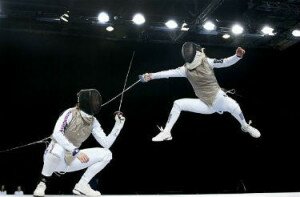Wounds of the flesh a surgeon’s skill may heal
but wounded honour can only be cured with steel
19th century challenge to a duel
The sword is two things – a weapon and a symbol. The blade itself inclines to deeds of violence, says Homer in his ancient epics. As a weapon, the sword has taken the lives of many; as a symbol, it has conquered the imagination of man, and what it means to be a man. “Know your enemy, know his sword”, says the famed duelist Miyamoto Musashi.
The sword has been a part of history from the earliest times. It evolved into a test of manliness in the melee of medieval tournaments. It became linked with honour in Japan and Europe, and much blood was spilt to heal wounded pride. By the modern era, after almost 50 centuries of continuous use, sword-mastery had evolved into a form of art. With the advent of the gunpowder warfare, it became a sport. The sport of fencing.
Fencing as a modern sport is made up of three disciplines, each with different scoring criteria and striking strategies:
- Foil – A light thrusting weapon (500g) which scores only on thrusts, i.e. the tip of the weapon has to hit the opponent. The scoring area is restricted to all parts of the torso. A foil competitor is called a foilist.
- Sabre – A light weapon (500g) with which the fencer scores with a thrust or a slash, i.e. the tip and the edge of the weapon. The scoring area is restricted to all parts of the arms, the torso and the head. A sabre competitor is called a sabreur.
- Epee – A heavier weapon (770g) with which the fencer scores only with thrusts. Any part of the body from the foot to the head may be targeted. An epee competitor is called an epeeist.
A central tenet which determines the strategy of fencing in foil and sabre is the rule of “right of way” (row). Row determines who may strike and who must defend during a match. If a person attacks and his blow is defended, then the right to attack passes to the defender. If the two fencers attack at the same time and hit, the point is awarded to the one who has row. Epee does not follow the role of row. This makes the attack and defense strategy of this division very different.
All divisions require that the fencer wears the following equipment:
- Plastron – A protector that covers the body and extends to cover the sword arm of the fencer.
- Croissard – A jacket worn over the plastron with a gorget to protect the neck.
- Glove – Bearing an extended gauntlet to protect the upper arm, a lone glove is worn on the sword arm.
- Breeches – Trousers ending just below the knee.
- Knee length socks.
- Reinforced shoes.
- Mask with bib to protect the neck.
Additional electric equipment is also worn for scoring purposes.
Fencing tournaments consist of team and individual events which take place across the various divisions. In the individual event, fencers compete in a round robin (rr, or all-play-all tournament), after which final match-ups are put together and elimination rounds begin. . In round robin rounds a match is won when a fencer scores 5 points; the eliminations, a match is won when a fencer scores 15 points. Round robin matches are a single round of 3 minutes, while elimination matches are 3 rounds of 3 minutes.
In team events, the winners are determined by total points.
Fencing is one of the rare sports to have been contested at every single one of the modern Olympics.

 Main blog
Main blog